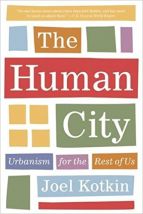The Human City: Urbanism for the Rest of Us

At first glance, Joel Kotkin’s The Human City may appear anti-urban, with its advocacy against urban densification policies. But it is Kotkin’s prioritization of the future of cities that drives this book. In The Human City, based on past experience and future predictions, Kotkin cautions against future problems linked to the densification of cities, which neglects the needs and desires of families. He asserts that we are losing the familial city, and in response calls for a new approach to urbanism that sees people and families as key parts that shape and constitute cities (page 201). In particular, Kotkin draws upon the experiences of North America, Asia (e.g. India, Singapore and Japan) and Europe to support his argument.
The Human City comprises seven chapters: What is a City For?; The Importance of Everyday Life; The Problem with Megacities; Inside the “Glamour Zone”; Post-Familial Places; The Case for Dispersion; and How Should We Live?
Chapter 1 is short. It sets out that people remain in cities to live well. To live well, Kotkin believes we must start by looking ahead to address the needs of future generations. This is what he calls “the human city”. In other words, this is a city that addresses the varying needs of its dwellers through their life cycles, and particularly focuses on areas where families (parents, children and the neighbourhoods that sustain them) are likely to live. According to Kotkin, core cities are not sustainable due to their low birth rates and high levels of income inequality. Yet planners rarely consider this fact and discourage suburban development in favour of density (page 17). In building a new approach to urbanism that makes “life better for the vast majority of citizens”,
Chapter 2 looks at “Everyday Life” (page 19). Kotkin contends that this is a basic element of cities, and reveals how and where people live. In order to hone our efforts to improve today’s cities, the main body of this chapter looks at the evolution of cities from spiritual centres to centres of political and economic power. City types Kotkin describes include: the City of God, the Imperial City, the Producer City, the Industrial City, the Rise of Suburbia, the Transactional City, the Socialist City, and the New Consumer City. He closes by highlighting the search for the Human City (page 45).
In Chapter 3, Kotkin looks at the rise of the modern megacity and discusses its associated problems, for both the present day and the urban future. Here he argues that conventional wisdom, which promotes dense urban areas to develop prosperity and improved living, falls short as inefficiencies plague megacities (page 55). Notably, housing shortages and poor infrastructure threaten improvements to health and wealth.
The fourth chapter delves inside the glamour zones of global cities, which “disproportionately attract the rich and serve as centres of luxury shopping, dining, and entertainment” (page 81). With a significant focus on Singapore, Kotkin discusses such areas’ physical and human connectivity, as well as the power of inertia. He also identifies the factors undermining their middle classes.
Chapter 5 discusses post-familial urbanism, as Kotkin builds upon his thesis that urban density typically leads to fewer or no children, and that families generally avoid high-density housing and therefore move out of city cores (page 116). Surprisingly, he identifies how this is seen vividly in East Asian cities. Kotkin considers the role of migration to support urban centres and concludes by emphasizing that “cities with few children and families will prove fundamentally unsustainable” (page 140).
Kotkin presents the case for dispersion in Chapter 6. He discusses both the British and American experiences, as well as the opposition to suburbanization from a sustainability stance. Whilst recognizing the value of the suburbs for families, Kotkin acknowledges the need for both types of areas. In conclusion, Kotkin returns to his initial question, “What is the city for?”
Having explored this through the book’s chapters, in Chapter 7 he “argues for a broader definition of what constitutes a city…to encompass not only different forms but also people in all their variety and various life stages…to include those broad sections of society…whose long-term interests are often ignored” – in other words, families (page 170). Kotkin emphasizes that the urban future will be formed by the millennial generation. He thus advocates for a new, grassroots approach to urbanism that encourages diverse urban forms, which develop in response to both markets and local residents, and sees people and families as essential elements of the city (page 201).
Book note prepared by Hannah Keren Lee
Search the Book notes database
Our Book notes database contains details and summaries of all the publications included in Book notes since 1993 - with details on how to obtain/download.
Use the search form above, or visit the Book notes landing page for more options and latest content.
For a searchable database for papers in Environment and Urbanization, go to http://eau.sagepub.com/

